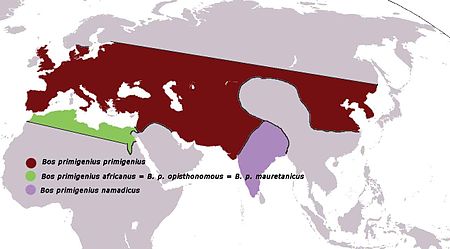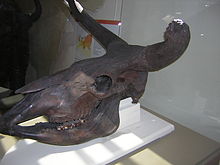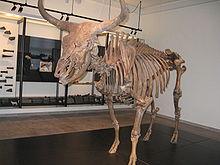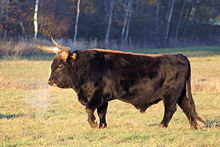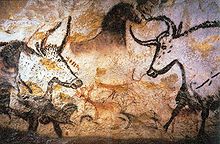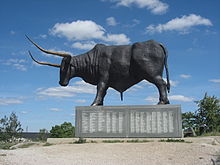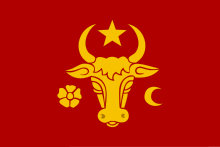- Aurochs
-
Aurochs
Temporal range: Late Pliocene to Holocene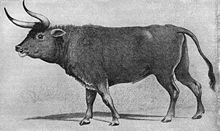
An Aurochs, from a 19th century copy of a painting owned by a merchant in Augsburg. The original probably dates to the 16th century. Conservation status Scientific classification Kingdom: Animalia Phylum: Chordata Class: Mammalia Order: Artiodactyla Family: Bovidae Subfamily: Bovinae Genus: Bos Species: †B. primigenius Binomial name †Bos primigenius Subspecies Bos primigenius primigenius
(Bojanus, 1827)
Bos primigenius namadicus
(Falconer, 1859)
Bos primigenius mauretanicus
(Thomas, 1881)Synonyms Bos mauretanicus Thomas, 1881
Bos namadicus Falconer, 1859The aurochs (
 /ˈaʊrɒks/ or /ˈɔrɒks/; also urus, Bos primigenius), the ancestor of domestic cattle, were a type of large wild cattle which inhabited Europe, Asia and North Africa, but is now extinct; it survived in Europe until 1627.
/ˈaʊrɒks/ or /ˈɔrɒks/; also urus, Bos primigenius), the ancestor of domestic cattle, were a type of large wild cattle which inhabited Europe, Asia and North Africa, but is now extinct; it survived in Europe until 1627.Aurochs bulls are believed to have reached a height of 1.8 metres (5 feet 10 inches) at the withers, and the cows to have been about 1.5 metres (4 feet 11 inches), displaying considerable sexual dimorphism.[2]
The aurochs was regarded as a challenging hunting quarry animal, contributing to its extinction. The last recorded aurochs, a female, died in 1627 in the Jaktorów Forest, Poland, and her skull is now the property of the Livrustkammaren ("Royal Armory") museum in Stockholm, Sweden.
Representations and descriptions of aurochs appear in prehistoric cave paintings, in Julius Caesar's The Gallic War, and as the national symbol of many European countries, states and cities such as Alba-Iulia, Kaunas, Romania, Moldavia, Turka, Mecklenburg, and Uri. The Swiss canton Uri was named after this animal species.
Domestication of bovines occurred in several parts of the world but at roughly the same time, about 8,000 years ago, possibly all derived from the aurochs. In 1920, the Heck brothers, who were German biologists, attempted to recreate aurochs. The resulting cattle are known as Heck cattle or Reconstructed Aurochs, and number in the thousands in Europe today. However, they are genetically and physiologically distinct from aurochs. The Heck brothers' aurochs also have a pale yellow dorsal stripe, instead of white.
Contents
Nomenclature
The words "aurochs", "urus", and "wisent" have all been used synonymously in English.[3][4] However, the extinct aurochs/urus is a completely separate species from the still-extant wisent.
The animal's original scientific name, Bos primigenius, was meant as a Latin translation of the German term Auerochse or Urochs, which was (incorrectly) interpreted as literally meaning "primeval ox" or "proto-ox". This scientific name is now considered invalid by the Integrated Taxonomic Information System (ITIS), which classifies aurochs under Bos taurus – the same species as domestic cattle. In 2003, however, the International Commission on Zoological Nomenclature "conserved the usage of 17 specific names based on wild species, which are pre-dated by or contemporary with those based on domestic forms",[5] confirming Bos primigenius for the Aurochs. Taxonomists who consider domesticated cattle a subspecies of the wild Aurochs should use B. primigenius taurus; the name B. taurus remains available for domestic cattle where it is considered to be a separate species.
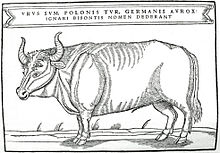 Illustration from Sigismund von Herberstein's book published in 1556 captioned "I'm 'urus', tur in Polish, aurox in German (dunces call me bison)";
Illustration from Sigismund von Herberstein's book published in 1556 captioned "I'm 'urus', tur in Polish, aurox in German (dunces call me bison)";
Latin original: Urus sum, polonis Tur, germanis Aurox: ignari Bisontis nomen dederantThe word "aurochs" comes to English from German, where its normal spelling and declension today is Auerochs/Auerochse (singular), Auerochsen (genitive), Auerochsen (plural). The declension in English varies, being either "auroch" (singular), "aurochs" (plural)[6][7] or "aurochs" (singular), "aurochses" (plural).[7] The declension "auroch" (singular), "aurochs" (plural), acknowledged by MWU,[7] is a back-formation analogous to "pea"-from-"pease" derived from a misinterpretation of the singular form ending in the /s/ sound (being cognate to "ox/Ochs(e)"). The use in English of the plural form "aurochsen" is not acknowledged by AHD4 or MWU, but is mentioned in The Cambridge Encyclopedia of the English Language.[8] It is directly parallel to the German plural and analogous (and cognate) to English "ox" (singular), "oxen" (plural).
The word "urus" (/ˈjʊərəs/) comes to English from Latin, but may have come to Latin from Germanic origins.[9] It declines in English as "urus" (singular), "uruses" (plural).[9][10]
Origin
According to the Paleontologisk Museum, University of Oslo, aurochs evolved in India some two million years ago, migrated into the Middle East and further into Asia, and reached Europe about 250,000 years ago.[11] They were once considered a distinct species from modern European cattle (Bos taurus), but more recent taxonomy has rejected this distinction.[citation needed] The South Asian domestic cattle, or zebu, descended from a different group of aurochs at the edge of the Thar Desert; this would explain the zebu's resistance to drought. Domestic yak, gayal and Javan cattle do not descend from aurochs. Modern cattle have become much smaller than their wild forebears. Aurochs were about 1.75 metres (5 ft 9 in) tall, while a very large domesticated cow is about 1.5 metres (4 ft 11 in) and most domestic cattle are much smaller than this.[12] Aurochs also had several features rarely seen in modern cattle, such as lyre-shaped horns set at a forward angle, a pale stripe down the spine, and sexual dimorphism of coat colour. Males were black with a pale eel stripe or finching down the spine, while females and calves were reddish (these colours are still found in a few domesticated cattle breeds, such as Jersey cattle). Aurochs were also known to have very aggressive temperaments and killing one was seen as a great act of courage in ancient cultures.[citation needed]
Subspecies
Three wild subspecies of aurochs are recognized. Only the Eurasian subspecies survived until recent times.:
- The Eurasian subspecies (Bos primigenius primigenius) once ranged across the steppes and taigas of Europe, Siberia, and Central Asia. It is part of the famous Pleistocene megafauna, and declined in numbers along with other megafauna species by the end of Pleistocene. The Eurasian aurochs were domesticated into modern taurine cattle breeds around the 6th millennium BC, in the Middle East, and possibly also at about the same time in the Far East. Aurochs were still widespread in Europe by the time of the Roman Empire, when they were widely popular as a battle beast in Roman arenas, and excessive hunting began and continued until it was nearly extinct. By the 13th century, aurochs existed only in low numbers in Eastern Europe, and hunting of aurochs became a privilege of nobles, and later royal households. The decreased hunting did not save the aurochs from extinction, and the last recorded live aurochs, a female, died in 1627 in the Jaktorów Forest, Poland from natural causes.
- The Indian subspecies (Bos primigenius namadicus), the Indian Aurochs, once lived in the hot and dry areas of India. It was the first subspecies of the aurochs to appear, at 2 million years ago, and from it descends the Eurasian Aurochs and the African Aurochs[citation needed], and from about 9000 BC it was domesticated as zebu cattle.[13]
- The North African subspecies (Bos primigenius mauretanicus), the African Aurochs, once lived in the woodland and shrubland of North Africa. It is descended from the Indian Aurochs, which migrated from the Middle East.[citation needed] It is unknown when the North African Aurochs became extinct. Prior to its extinction the Ancient Egyptians may have domesticated the African Aurochs into Egyptian cattle,[citation needed] which was the primary breed of cattle in the Mediterranean region[citation needed] until the introduction of zebu from India, which slowly replaced Egyptian cattle in the region.[clarification needed]
Behavioral patterns
The recovery pattern of aurochs remains led to the belief that they preferred swampy and wet wooded areas and, like modern cattle, could swim for short distances, enabling them to inhabit islands within their range. Their diet is thought to have consisted of green grass and leaves, with occasional tree fruits. Aurochs species were found to have lived on the island of Sicily, where once there was a land bridge to Italy. After the disappearance of the land bridge, Sicilian aurochs evolved to a size 20% smaller than their mainland relatives. Although the European bison prefers drier forest, they would most certainly have lived in areas overlapping aurochs territory. Little else is known about Aurochs habits. Although they survived until the 17th century in Poland, both the fact that they were in competition with modern cattle for food and hunted by humans contributed to their extinction.[14]
Genetics
The first complete mitochondrial genome (16,338 base pairs) DNA sequence analysis of Bos primigenius from an archaeologically verified and exceptionally well preserved aurochs bone sample was published in 2010.[15]
Domestication and extinction
The aurochs, which ranged throughout much of Eurasia and Northern Africa during the late Pleistocene and early Holocene, is widely accepted as the wild ancestor of modern cattle. Archaeological evidence shows that domestication occurred independently in the Near East and the Indian subcontinent between 10,000–8,000 years ago, giving rise to the two major domestic taxa observed today — humpless Bos taurus (taurine) and humped Bos indicus (zebu), respectively. This is confirmed by genetic analyses of matrilineal mitochondrial DNA sequences, which reveal a marked differentiation between modern Bos taurus and Bos indicus haplotypes, demonstrating their derivation from two geographically and genetically divergent wild populations.[15]
Domestication of the aurochs began in the southern Caucasus and northern Mesopotamia from about the 6th millennium BC, while genetic evidence suggests that aurochs were independently domesticated in India and possibly in northern Africa.[16] Domesticated cattle and aurochs are so different in size that they have been regarded as separate species; however, large ancient cattle and aurochs "are difficult to classify because morphological traits have overlapping distributions in cattle and aurochs and diagnostic features are identified only in horn and some cranial element."[14][17]
Comparison of aurochs bones with those of modern cattle has provided many insights about the aurochs. Remains of the beast, from specimens believed to have weighed more than a ton, have been found in Mesolithic sites around Goldcliff, Wales.[18] Though aurochs became extinct in Britain during the Bronze age, analysis of bones from aurochs that lived in the same age as domesticated cattle there showed no genetic contribution to modern breeds. As a result of this study, modern European cattle were thought to have descended directly from the Near East domestication. Another study, however, found distinct similarities between modern breeds and Italian aurochs specimens suggesting that the previously tested British aurochs were not a good model of the diversity of aurochs genetics and suggesting possible North African and European aurochs input to domestic breeds.[17]
Indian cattle (zebu), although domesticated eight to ten thousand years ago, are related to aurochs which diverged from the Near Eastern ones some 200,000 years ago. African cattle are thought to descend from aurochs more closely related to the Near Eastern ones. The Near East and African aurochs groups are thought to have split some 25,000 years ago, probably 15,000 years before domestication. The "Turano-Mongolian" type of cattle now found in Northern China, Mongolia, Korea and Japan may represent a fourth domestication event (and a third event among Bos taurus–type aurochs). This group may have diverged from the Near East group some 35,000 years ago. Whether these separate genetic populations would have equated to separate subspecies is unclear.
The maximum range of the aurochs was from Europe (excluding Ireland and northern Scandinavia), to northern Africa, the Middle East, India and central Asia.[19][20] By the 13th century A.D., the aurochs' range was restricted to Poland, Lithuania, Moldavia, Transylvania and East Prussia. The right to hunt large animals on any land was restricted to nobles and gradually to the royal household. As the population of aurochs declined, hunting ceased but the royal court still required gamekeepers to provide open fields for the aurochs to graze in. The gamekeepers were exempted from local taxes in exchange for their service and a decree made poaching an aurochs punishable by death. In 1564, the gamekeepers knew of only 38 animals, according to the royal survey. The last recorded live aurochs, a female, died in 1627 in the Jaktorów Forest, Poland from natural causes. The skull was later looted by the Swedish Army during the Swedish invasion of Poland (1655–1660) and is now the property of Livrustkammaren in Stockholm. The causes of extinction were hunting, a narrowing of habitat due to the development of farming, climatic changes, and diseases transmitted by domestic cattle.[21]
Re-creation
In the 1920s two German zoo directors (in Berlin and Munich), the brothers Heinz and Lutz Heck, began a selective breeding program in the attempt to breed back the aurochs into existence from the domestic cattle that were their descendants. Their plan was based on the concept that a species is not extinct as long as all its genes are still present in a living population. The result is the breed called Heck cattle, "Recreated Aurochs", or "Heck Aurochs", which bears some resemblance to what is known about the appearance of the wild aurochs.[14]
Scientists of the Polish Foundation for Recreating the Aurochs (PFOT) in Poland want to use DNA from bones in museums to recreate the aurochs and return this animal to the forests of Poland. The project has gained the support of the Polish Ministry of the Environment. They plan research on ancient preserved DNA. Other research projects[which?] have extracted "ancient" DNA over the past twenty years and their results published in such periodicals as Nature and Proceedings of the National Academy of Sciences USA.[Full citation needed] Polish scientists believe that modern genetics and biotechnology make recreating an animal almost identical to aurochs possible. They say this research will lead to examining the causes of the extinction of the aurochs, and help prevent a similar occurrence with domestic cattle.[22][citation needed]
In a similar program, Project Tauros[23] is trying to DNA sequence breeds of modern cattle to find gene sequences which match those found in "ancient DNA" from aurochs samples. The modern cattle would then be selectively bred to try to bring the aurochs-type genes back into a single animal.[24] Johan van Arendonk, a professor of animal-breeding and genetics at Wageningen University is quoted as saying, "It's still a very open question if it all can be done."
Art, history, mythology, and media
- Aurochs are depicted in many Paleolithic European and Mesopotamia cave paintings such as those found at Lascaux and Livernon in France. When drawn in profile only one horn was visible, which some researchers say gave rise to the legend or Greek mythos of the unicorn. Early carvings of the aurochs have also been found. The impressive and dangerous aurochs survived into the Iron Age in Anatolia and the Near East, and was worshipped throughout that area as a sacred animal, the Lunar Bull, associated with the Great Goddess[which?] and later with Mithras.
- A 1999 archaeological dig in Peterborough, England, uncovered the skull of an aurochs. The front part of the skull had been removed but the horns remained attached. The supposition is that the killing of the aurochs in this instance was a sacrificial act.
- Aurochs are depicted on the Ishtar Gate.
- The ancient name of the Estonian town of Rakvere, Tarwanpe or Tarvanpea, probably derives from Auroch's head (Tarva pea) in ancient Estonian. A 3.5m high and 7.1m long Statue of an Aurochs was erected in Rakvere in 2002, for the town's 700th birthday. The sculpture, made by artist Tauno Kangro, has become a symbol of the town.[25]
- The wild-ox called re'em (Strong's # 07214) in the Bible (Numbers 23:22 and 24:8, Deuteronomy 33:17, Job 39:9–10, Psalms 22:21, 29:6, 92:10 and Isaiah 34:7) is occasionally associated with the aurochs and has incorrectly been translated as "unicorn" in the past (The International Standard Bible Encyclopedia, Entry for 'Wild Ox', Copyright, 1939, by Wm. B. Eerdmans Publishing Co.).
- Julius Caesar wrote about aurochs in Gallic War Chapter 6.28, "...those animals which are called uri. These are a little below the elephant in size, and of the appearance, color, and shape of a bull. Their strength and speed are extraordinary; they spare neither man nor wild beast which they have espied. These the Germans take with much pains in pits and kill them. The young men harden themselves with this exercise, and practice themselves in this sort of hunting, and those who have slain the greatest number of them, having produced the horns in public, to serve as evidence, receive great praise. But not even when taken very young can they be rendered familiar to men and tamed. The size, shape, and appearance of their horns differ much from the horns of our oxen. These they anxiously seek after, and bind at the tips with silver, and use as cups at their most sumptuous entertainments."
- An aurochs head, the traditional arms of the German region Mecklenburg, is included in the coat of arms of Mecklenburg-Vorpommern. The aurochs ("bour" in Romanian, probably derived from lat. bos urus → bourus → bour) was also the symbol of Moldavia; nowadays they can be found in the coat of arms of both Romania and Moldova. The horn of the aurochs is a charge of the coat of arms of Tauragė, Lithuania (the name itself of Tauragė is derived from "tauras" and "ragas", meaning "auroch" and "horn"). It is also present in the emblem of Kaunas, Lithuania, and was part of the emblem of Bukovina during its time as a Kronland of Austria-Hungary. The Swiss Canton of Uri is named after the aurochs; its yellow flag shows a black aurochs head.
- East Slavic surnames Turenin, Turishchev, Turov, Turovsky originate from the East Slavic name of the species (Tur).[26]
- Turopolje, a large lowland floodplain south of the Sava river in Croatia, got its name after the once abundant aurochs (Croatian: tur).
- The Aurochs is one of the animals available in Zoo Tycoon 2: Extinct Animals.
See also
Notes
This article incorporates Creative Commons CC-BY-2.5 text from reference.[15]
- ^ Tikhonov, A. (2008). Bos primigenius. In: IUCN 2008. IUCN Red List of Threatened Species. Downloaded on 5 January 2008.
- ^ van Vuure, T.. History, morphology and ecology of the Aurochs (chapter 3.2: Morphology). Wageningen, The Netherlands. p. 4. http://members.chello.nl/~t.vanvuure/oeros/uk/lutra.pdf.
- ^ AHD4, headwords "aurochs", "urus", "wisent".
- ^ MWU, headwords "aurochs", "urus", "wisent".
- ^ ICZN, Biodiversity Studies
- ^ AHD4, headword "aurochs".
- ^ a b c MWU, headword "aurochs".
- ^ Crystal, David (2003). The Cambridge Encyclopedia of the English Language (2nd ed. ed.). Cambridge University Press. ISBN 0521530334.
- ^ a b AHD4, headword "urus".
- ^ MWU, headword "urus".
- ^ Paleontologisk Museum
- ^ Height of Holstein cows (at hips – note that cattle are often slightly taller at the withers than the hips).
- ^ In the Light of Evolution III: Two Centuries of Darwin (2009), page 96, National Academies Press
- ^ a b c Cis T Van Vuure, Retracing the Aurochs: History, Morphology and Ecology of an Extinct Wild Ox, Aurochs (Extinct Species, Mammals), The Extinction Website
- ^ a b c Edwards C.J., Magee D.A., Park S.D.E., McGettigan P.A., Lohan A.J., et al. (2010). "A Complete Mitochondrial Genome Sequence from a Mesolithic Wild Aurochs (Bos primigenius)". PLoS ONE 5(2): e9255. doi:10.1371/journal.pone.0009255.
- ^ Bradley DG, MacHugh DE, Cunningham P, Loftus RT, "Mitochondrial diversity and the origins of African and European cattle", Proceedings of the National Academy of Science, U S A, May 14, 1996; 93(10):5131-5.
- ^ a b The origin of European cattle: Evidence from modern and ancient DNA, Albano Beja-Pereira, et al., PNAS, May 23, 2006, vol. 103, no. 21, 8113–8118
- ^ "Rescuing a Mesolithic foreshore". Time Team. 2004-02-22. No. 8, season 11.
- ^ (PDF) History, Morphology And Ecology Of The Aurochs. http://members.chello.nl/~t.vanvuure/oeros/uk/lutra.pdf. Retrieved 2011-08-09.
- ^ McKenzie, Steven (2010-02-17). "Ancient giant cattle genome first". BBC News. http://news.bbc.co.uk/2/hi/uk_news/scotland/highlands_and_islands/8516598.stm.
- ^ Rokosz’, Mieczyslaw (1995). "History of the Aurochs (Bos Taurus Primigenius) in Poland". Animal Genetics Resources Information (Food and Agriculture Organization) 16: 5–12. http://agtr.ilri.cgiar.org/agtrweb/Documents/Library/docs/agri16_95.pdf.
- ^ Polish geneticists want to recreate the extinct auroch; 2007-11-28; Science and Scholarship in Poland; Polish Press Agency (PAP)
- ^ Stichting Taurus Vee, 2010 (Dutch)]
- ^ Breeding Ancient Cattle Back from Extinction, TIME, Stephan Faris, Feb. 12, 2010
- ^ Rakvere linn (Estonian)
- ^ Russian Surnames. Popular Etymological Dictionary. Yu. A. Fedosyuk. 6th Ed.
References
- American Heritage Dictionary of the English Language, 4th edition (AHD4). Houghton Mifflin, 2000. Headwords aurochs, urus, wisent.
- Bunzel-Drüke, M. 2001. Ecological substitutes for Wild Horse (Equus ferus Boddaert, 1785 = E. przewalslii Poljakov, 1881) and Aurochs (Bos primigenius Bojanus, 1827). Natur- und Kulturlandschaft, Höxter/Jena, 4, 10 p. AFKP. Online pdf (298 kB)
- C. Julius Caesar. Caesar's Gallic War. Translator. W. A. McDevitte. Translator. W. S. Bohn. 1st Edition. New York. Harper & Brothers. 1869. Harper's New Classical Library.
- International Commission on Zoological Nomenclature. 2003. Opinion 2027 (Case 3010). Usage of 17 specific names based on wild species which are pre-dated by or contemporary with those based on domestic animals (Lepidoptera, Osteichthyes, Mammalia): conserved. Bull.Zool.Nomencl., 60:81–84.
- Merriam-Webster Unabridged (MWU). (Online subscription-based reference service of Merriam-Webster, based on Webster's Third New International Dictionary, Unabridged. Merriam-Webster, 2002.) Headword aurochs. Accessed 2007-06-02.
- Shaffer, Jim G. (1995). Cultural tradition and Palaeoethnicity in South Asian Archaeology. In: Indo-Aryans of Ancient South Asia. Ed. George Erdosy. ISBN 8121507901
- Shaffer, Jim G. (1999). Migration, Philology and South Asian Archaeology. In: Aryan and Non-Aryan in South Asia. Ed. Bronkhorst and Deshpande. ISBN 1-888789-04-2.
- Vuure, T. van. 2002. History, morphology and ecology of the Aurochs (Bos primigenius). Lutra 45-1. Online pdf (603 kB)
- Vuure, C. van. 2005. Retracing the Aurochs: History, Morphology and Ecology of an Extinct Wild Ox. Pensoft Publishers. Sofia-Moscow.
- Wilson, Don E. and DeeAnn M. Reeder: Mammals.
External links
- The Extinction Website - Aurochs (Bos primigenius primigenius)
- History of aurochs in Poland
- Breeding Back the Aurochs 2005, web-paper by student Magdalena Michalak at Bryn Mawr College, near Pennsylvania, Philadelphia.
- The Aurochs is coming back to European forests and grasslands
Categories:- IUCN Red List extinct species
- Extinct mammals of Europe
- Megafauna of Eurasia
- Extinct mammals
- Extinct mammals of Asia
- Species made extinct by human activities
- Bovines
- Pliocene mammals
- Pleistocene mammals
- Holocene extinctions
- Mammal extinctions since 1500
- Prehistoric bovids
Wikimedia Foundation. 2010.




